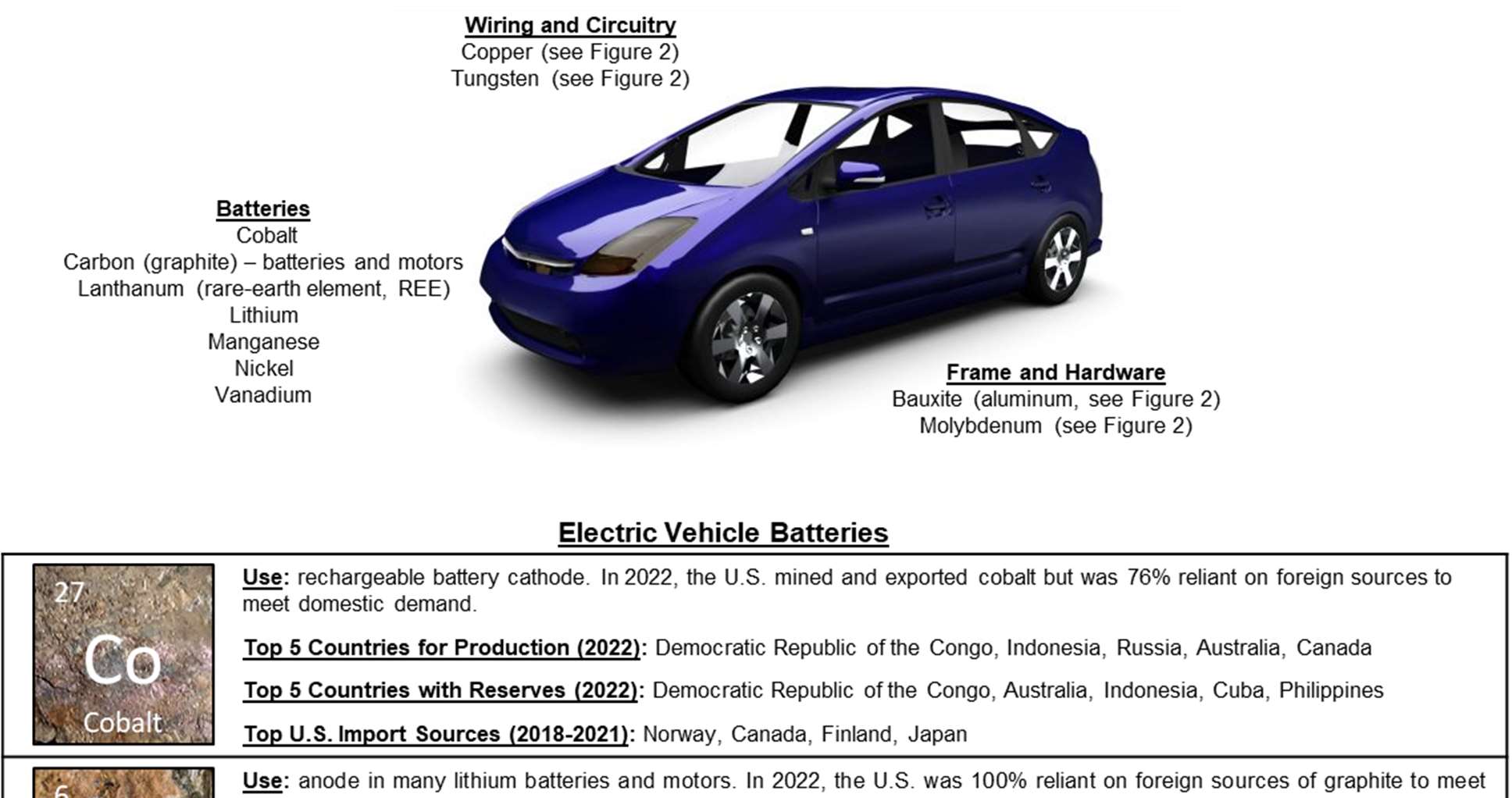Listen Now
Critical minerals are essential to advancing energy transition technologies in the United States (U.S.). Manufacturing products that generate, store, and release alternative clean and renewable energy, such as electric car batteries, wind turbines, and solar panels, rely on the availability of critical minerals.
Issue
Manufacturing in the U.S. will rely on securing access to critical minerals to meet society's increasing demand for alternative clean and renewable energy transition technologies. Critical minerals are defined as non-fuel minerals or mineral materials that are essential to the U.S. economy and national security, and are susceptible to supply chain disruption (USDOE 2020, USGS 2022). Since mineral market and supply chain analyses are regularly updated as new information becomes available, and society’s demand for raw materials used to manufacture products and drive technological innovation can change, The Energy Act of 2020 (USDOE 2020) requires a review, and update if needed, of the identified critical minerals at least once every three years.
Not all critical minerals are readily available (e.g., currently discovered, mined, or processed) in the U.S, to support manufacturing the products needed in energy transition technologies. When a sufficient domestic supply of critical minerals is unavailable, the U.S. relies on foreign imports to secure minerals required for manufacturing renewable energy and other products. Identifying and developing domestic sources of critical minerals will assist in meeting the demand and strengthening domestic supply chains for alternative and energy transition technologies in the U.S.
Background
The U.S. began identifying critical minerals during World War I, when nickel, nitrates, platinum, potash, and tin were among those recognized to be important to the war effort but limited in domestic supply. In 1917, Mineral Resources in War and Their Bearing on Preparedness (Pogue 1917) was published and presented ongoing research in mineral commodity availability and demand. The first modern U.S. list of critical minerals was drafted by the United States Geological Survey (USGS) for the United States Department of the Interior (USDOI) in 2018 and included 35 mineral commodities (USGS 2018, USDOI 2018).
In 2022, the USGS released an updated list of critical minerals that included 50 mineral commodities (USGS 2022). The increase in 15 total critical minerals reported included minerals both added to and removed from the previous list based on current supply, demand, and production data, and applicable U.S. policy. The International Energy Agency (IEA) identified additional minerals as "important” for clean energy technologies (e.g., electric cars, wind turbines, solar panels) that were not included in the USGS 2022 update, such as copper, molybdenum, and silicon (IEA 2021).
The USGS publishes information for a number of mineral commodities including but not limited to those the U.S. currently considers critical. Information such as import and export statistics, commodity trends, and world production and reserve estimates, is updated on an annual basis and published in individual Mineral Commodity Summaries. These publications (USGS 2023) were used to illustrate critical and “important” minerals for manufacturing electric vehicles, wind turbines, and solar panels in Figures 1, 2, and 3, respectively.

.jpg)
.jpg)
Figure 1. Critical minerals for electric vehicle batteries (USGS 2023).
.jpg)
.jpg)
Figure 2. Critical minerals for wind turbines (USGS 2023).
.jpg)
.jpg)
Figure 3. Critical minerals for solar panels (USGS 2023).
SME Statement of Technical Position
SME supports the following goals to improve the reliable sourcing of critical minerals and advancing renewable and energy transition technologies, specifically the manufacturing of electric car batteries, wind turbines, and solar panels:
- Identifying and developing domestic sources of critical minerals and securing reliable sources of foreign imports where a domestic source is not identified.
- Quantifying U.S. critical mineral demand relative to availability.
- Maintaining U.S. global technical and economic competitiveness.
- Facilitating domestic research, publication, education, and training in approaches to exploration, mining and processing critical minerals through collaboration between government, industry, and academia.
- Developing reprocessing and recycling technologies to recover critical minerals from mine waste materials (e.g., tailings, waste rock, products at end of life).
- Increasing domestic mining and processing capacity for critical minerals to meet increasing societal demand for energy transition and renewable energy technologies.
- Adopting safe, reliable, and secure policies that encourage development of technologies to support alternative energy transition and renewable energy, including streamlining permitting approvals for projects that will increase discovery and development of domestic critical minerals.
- Effectively engaging the public through outreach to convey the importance of critical minerals in the U.S. energy transition and development of renewable energy technologies, meeting the U.S. carbon emission reduction goals, and maintaining U.S. national security.
IEA (International Energy Agency). 2021. The Role of Critical minerals in Clean Energy Transitions.
https://www.iea.org/reports/the-role-of-critical-minerals-in-clean-energy-transitions/executivesummary
Pogue, Joseph E. 1917. Mineral Resources in War and Their Bearing on Preparedness. The Scientific Monthly, Vol. 5, No. 2 (Aug., 1917), pp. 120-134.
USDOE (United States Department of Energy). 2020. Energy Act of 2020. https://www.directives.doe.gov/ipt_members_area/doe-o-436-1-departmental-sustainabilityipt/ background-dE.ocuments/energy-act-of-2020/view
USDOI (United States Department of the Interior). 2018. Final List of Critical Minerals 2018.
https://www.federalregister.gov/documents/2018/05/18/2018-10667/final-list-of-critical-minerals- 2018
USGS (United States Geological Society). 2018. Draft Critical Mineral List – Summary of Methodology and Background Information – U.S. Geological Survey Technical Input Document in Response to Secretarial Order No. 3359.
https://pubs.usgs.gov/of/2018/1021/ofr20181021.pdf
USGS. 2019. Critical Mineral Commodities in Renewable Energy.
https://www.usgs.gov/media/images/critical-mineral-commodities-renewable-energy
USGS. 2022. 2022 Final List of Critical Minerals.
https://www.usgs.gov/news/national-news-release/usgeological- survey-releases-2022-list-critical-minerals
USGS. 2023. Mineral Commodity Summaries.
https://pubs.usgs.gov/periodicals/mcs2023/mcs2023.pdf
